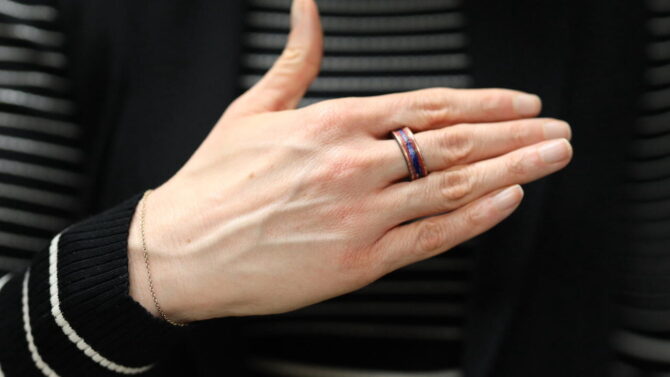
U of Waterloo researchers create powerful, miniaturized antenna
By Media Relations, University of Waterloo
Electronics Wireless Engineering Medical Wearable Technology engineering medical research university Waterloo wearablesNon-invasive health monitor ring collects, transmits vital health data over airwaves
University of Waterloo engineers have invented a powerful antenna small enough to fit in a ring and capable of transmitting critical medical data to health care workers and individual patients.
The ring, small enough to be worn like a piece of jewelry, contains a tiny antenna that can safely send medical-related information to smartphones or a health clinic over long distances through airwaves. This breakthrough is the first step to creating a device that can be used for non-invasive medical sensing applications such as monitoring blood and oxygen levels, assessing one’s fitness or tracking Parkinson’s disease.

The ring, small enough to be worn like a piece of jewelry, contains a tiny antenna that can safely send medical-related information to smartphones or a health clinic over long distances through airwaves. Source: University of Waterloo
“There is a revolution going on in the wireless sensing world,” explained lead researcher Dr. Omar Ramahi, a professor at the Department of Electrical and Computer Engineering. “But this revolution cannot succeed without the antenna.”
Internet of Medical Things
This novel ring is classified as an Internet of Medical Things (IoMT) device, which is characterized as tools and applications that work together through a network that can monitor vital signs and track disease progression. These biomedical monitoring systems include wearable antennas which help maintain wireless links and transmit information collected by sensors throughout the body.
Wearable antenna development has exploded over the past decade thanks to the advent of digital smartwatches, wristbands and eyeglasses which typically use Bluetooth wireless technology. Conventional antennas used in smartphones that transmit data don’t work for these devices, creating a challenge for researchers looking to create new IoMT devices.
Make it comfortable to wear
“When it comes to wearable medical devices, it’s the size of the antennas that causes design issues, not the transmitters and receivers which can be easily miniaturized,” said Rania Rabhi, a visiting scholar from Tunisia who developed the ring with Ramahi.
In addition to the antenna’s tiny size and need to be efficient, the researchers had to consider how to make it comfortable to wear, flexible and compact while ensuring a low absorption rate for radiation.
The antenna also needs to operate within a band of wireless spectrum reserved solely for medical information, similar to how smartphones connect to a 5G network. The ring, powered by a compact, rechargeable battery, meets all these requirements.
Operates on a thin, flexible high-frequency laminate
Ramahi credits Rabhi, as the “artist and engineer” who devised the ring’s antenna to operate on a thin and flexible high-frequency laminate that can be bent and wrapped around a human finger. This means the wearer can be physically active without being encumbered by the presence of the antenna.
The team hopes to see the miniaturized, wearable antenna used in health care settings to send vital data to doctors without the need for regular, in-person check-ups — which could result in a more efficient and resourceful health care system.
—————————–
The study, “A Miniaturized Wearable Finger-Ring Antenna for Medical Sensing at 2.45 GHz ISM Band,” was recently published in IEEE.
